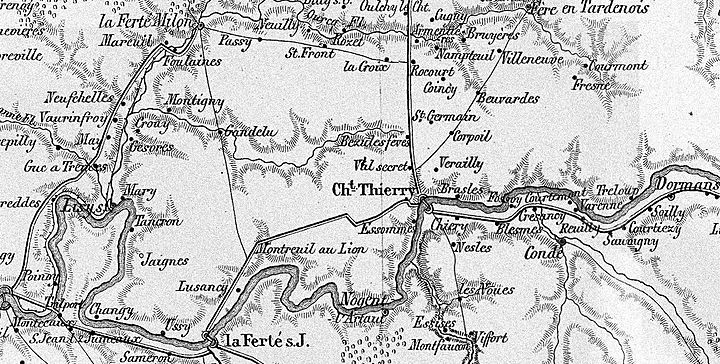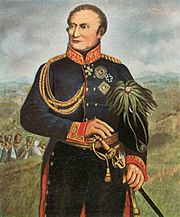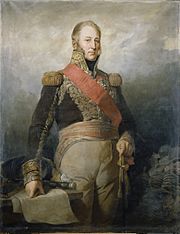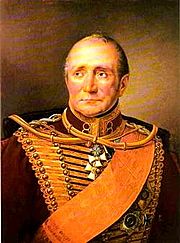Battle of Gué-à-Tresmes facts for kids
Quick facts for kids Battle of Gué-à-Tresmes |
|||||||
|---|---|---|---|---|---|---|---|
| Part of the Campaign of France of the Sixth Coalition | |||||||
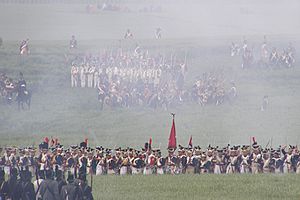 Kleist's Prussians may have witnessed a scene like this as the 2nd Old Guard Division advanced toward them. Photo is from a reenactment of the Battle of Waterloo. |
|||||||
|
|||||||
| Belligerents | |||||||
| Commanders and leaders | |||||||
| Strength | |||||||
| 10,000–14,000 | 12,000 | ||||||
| Casualties and losses | |||||||
| 250 killed, wounded, or captured | Prussia: 945–1,035 killed, wounded, or captured Russia: 400 killed, wounded, or captured Total casualties: 1,345–1,435 killed, wounded, or captured |
||||||
The Battle of Gué-à-Tresmes was a fight that happened on February 28, 1814, and continued into March 1, 1814. It was part of the War of the Sixth Coalition, where many European countries teamed up against Napoleon's France.
In this battle, about 14,500 French soldiers, led by Auguste de Marmont and Édouard Mortier, fought against 12,000 Prussian and Russian troops. The Allied forces were commanded by Friedrich Graf Kleist von Nollendorf and Peter Mikhailovich Kaptzevich.
The battle took place near a small stream called Thérouanne, close to the town of Meaux in France. The French managed to push the Prussian forces back. Even though the Allies tried to fight back and cross a river, they were not successful. This battle was a victory for the French army.
| Top - 0-9 A B C D E F G H I J K L M N O P Q R S T U V W X Y Z |
Background: The War Against Napoleon
Allies Push Towards Paris
In early 1814, many countries were fighting against Napoleon in what was called the War of the Sixth Coalition. The Allied armies, including Prussia, Russia, and Austria, were pushing into France. Their goal was to reach Paris, the capital city.
One of the main Allied armies was led by Gebhard Leberecht von Blücher, a Prussian general. His army, called the Army of Silesia, was moving west towards Paris. They were trying to get past the French forces defending the city.
Napoleon's Army on the Move
Napoleon's army was much smaller than the combined Allied forces. He had to move quickly to stop different Allied armies from reaching Paris. After a victory at the Battle of Montereau on February 18, Napoleon forced the Austrian army to retreat.
However, Blücher's army continued its advance. Napoleon wasn't sure exactly where Blücher was going. He had to guess and send his marshals (top generals) to try and block the Allied path.
French Marshals Defend the Marne
Marshals Auguste de Marmont and Édouard Mortier were in charge of a smaller French force. They tried to slow down Blücher's army. They burned bridges to make it harder for the Allies to cross rivers.
On February 27, Marmont's troops reached Meaux. They found Russian soldiers already there. Marmont quickly attacked and pushed the Russians back, taking control of the bridge at Meaux and destroying it. This was important to stop the Allies from crossing the Marne River.
Meanwhile, a Prussian force led by Friedrich Graf Kleist von Nollendorf crossed the Marne and moved towards Lizy-sur-Ourcq. This put them in a dangerous position for the French. Napoleon, realizing Blücher was heading for Paris, started marching his main army to help Marmont and Mortier.
The Battle of Gué-à-Tresmes
February 28: French Attack
On February 28, Kleist's Prussian soldiers rebuilt a bridge over the Ourcq river at Lizy. They crossed to the west side and moved southwest. Marmont and Mortier realized that Kleist was trying to get around their left side near Lizy.
So, the French marshals moved their troops northeast towards Lizy. Around 4:00 pm, the French advanced guard, led by Vincent, met Kleist's forward troops at Gué-à-Tresmes. French cavalry charged and pushed back the Prussian outposts.
The French 2nd Old Guard Division, led by Charles-Joseph Christiani, arrived with 24 cannons. They started firing at the Prussian positions. The French attacked Gué-à-Tresmes directly and from the side, forcing the Prussian soldiers to retreat.
As Kleist's troops fell back, they destroyed the bridge at Lizy. Marmont's soldiers chased the Prussians aggressively. The Prussians tried to make a stand at Le Plessis-Placy, but the French kept pushing them back. By midnight, Kleist's corps was forced behind the Gergogne stream.
During this fighting, the Prussians lost over 900 soldiers. The French lost about 250.
March 1: Allied Counterattacks Fail
On March 1, Blücher learned that Napoleon's main army was getting close. Remembering how Napoleon had beaten him before, Blücher quickly started moving his army to the north side of the Marne River. By 2:00 pm, Napoleon's cannons were firing across the river, but it was too late to catch the main Allied force.
Blücher wanted Kleist to keep fighting Marmont and Mortier. He also ordered other Allied units, like Ludwig Yorck von Wartenburg's Prussians and Peter Mikhailovich Kaptzevich's Russians, to attack the French.
Yorck tried to cross the Ourcq river at Crouy-sur-Ourcq, but the bridge was destroyed. Kaptzevich tried to force a crossing at Gesvres. Despite facing French cavalry, Kaptzevich's leading soldiers managed to get to the west bank.
However, Marmont quickly brought up his infantry. After a tough fight, the French pushed back Kaptzevich's small group, capturing about 280-300 Russian soldiers. Kleist's attack also failed. Both sides ended up in the same positions as before.
That night, more French troops and cannons arrived, cheering loudly. Even though the Allies had more soldiers overall, their spirits were low because they couldn't break through the French lines.
Aftermath
Allied Retreat
On March 2, Blücher decided to retreat north towards Soissons. His different army groups pulled back in various directions. Kleist's troops were the last to leave. They sent a small force to check on the French.
This force, led by Hans Ernst Karl, Graf von Zieten, included cavalry and artillery. They met French cavalry and infantry. After a cannon fight where the Prussians lost six guns, Zieten decided to retreat. Kleist's forces also managed to get away.
Napoleon's army was slowed down because they didn't have a special bridge-building train. They finally crossed the Marne River early on March 3. Napoleon planned to push the Allies back further.
On March 3, Marmont and Mortier also crossed the Ourcq river. There was a small fight at Neuilly-Saint-Front, where the French tried to trap the retreating Allies. The French caused about 500-600 casualties to Blücher's army.
Blücher continued to retreat, hoping to meet up with other Allied forces. He finally decided to pull back behind the Aisne River. The next major battle in this campaign would be the Battle of Craonne on March 7, 1814.
Forces Involved
French Army Units
| Corps | Division | Brigade | Units |
|---|---|---|---|
| Guard Corps: Marshal Édouard Mortier |
2nd Old Guard Division: General of Division Charles-Joseph Christiani |
Unknown commander | Fusilier Chasseur Regiment |
| Fusilier Grenadier Regiment | |||
| Vélites of Turin | |||
| General of Brigade Jean-Louis Gros |
Flanqueur Chasseur Regiment | ||
| Flanqueur Grenadier Regiment | |||
| Vélites of Florence | |||
| 2nd Young Guard Division: General of Division Philibert Jean-Baptiste Curial |
General of Brigade Lagrange |
5th Voltiguer Regiment | |
| 6th Voltiguer Regiment | |||
| General of Brigade Jacques Le Capitaine |
7th Voltiguer Regiment | ||
| 8th Voltiguer Regiment | |||
| VI Corps: Marshal Auguste de Marmont |
3rd Division: General of Division Joseph Lagrange |
General of Brigade Joseph Antoine de Joubert |
23rd and 37th Light Infantry Regiments |
| 15th and 16th Line Infantry Regiments | |||
| 70th and 121st Line Infantry Regiments | |||
| General of Brigade Jean-Louis Fournier |
1st and 62nd Line Infantry Regiments | ||
| 132nd Line Infantry Regiment | |||
| 1st, 2nd, 3rd and 4th Marine Regiments | |||
| 8th Division: General of Division Étienne Pierre Sylvestre Ricard |
General of Brigade Pierre Pelleport |
6th Light Infantry Regiment | |
| 4th and 6th Line Infantry Regiments | |||
| 136th Line Infantry Regiment | |||
| General of Brigade Pierre Clavel |
6th and 19th Light Infantry Regiments | ||
| 138th and 144th Line Infantry Regiments | |||
| 1st Cavalry Division: General of Division Jean-Pierre Doumerc |
General of Brigade Cyrille Simon Picquet |
1st Gardes d'Honneur Regiment | |
| 10th Hussar Regiment | |||
| Unknown | 1st Provisional Hussar Regiment | ||
| 2nd, 3rd and 4th Provisional Chasseurs à Cheval Regiments | |||
| I Cavalry Corps: General of Division Étienne Tardif de Bordesoulle |
1st Light Cavalry Division: General of Division Christophe Antoine Merlin |
General of Brigade Pierre François Antoine Huber |
6th, 7th and 8th Hussar Regiments |
| 1st, 3rd and 5th Chevau-léger Lancer Regiments | |||
| 7th and 8th Chevau-léger Lancer Regiments | |||
| General of Brigade Antoine Latour-Foissac |
1st, 2nd and 3rd Chasseurs à Cheval Regiments | ||
| 6th, 8th and 9th Chasseurs à Cheval Regiments | |||
| 16th and 25th Chasseurs à Cheval Regiments | |||
| 1st Heavy Cavalry Division: General of Division Étienne Tardif de Bordesoulle |
General of Brigade Nicolas Marin Thiry |
2nd and 3rd Cuirassier Regiments | |
| 6th and 9th Cuirassier Regiments | |||
| 11th and 12th Cuirassier Regiments | |||
| General of Brigade Joseph Alexandre Félix Laville |
4th, 7th and 14th Cuirassier Regiments | ||
| 7th and 23rd Dragoon Regiments | |||
| 28th and 30th Dragoon Regiments |
Allied Army Units
| Corps | Division | Brigade | Units |
|---|---|---|---|
| II Corps: General-Leutnant Friedrich Kleist von Nollendorf 9,800 men |
Infantry | 9th Brigade: Generalmajor Franz Friedrich von Klüx |
1st West Prussian Infantry Regiment (1st, 2nd and Fusilier Battalions) |
| 6th Reserve Infantry Regiment (two battalions) | |||
| Silesian National Hussar Regiment (four squadrons) | |||
| 7th Silesian Landwehr Cavalry Regiment (four squadrons) | |||
| 6-pounder Foot Battery Nr. 7 (Eight 6-pound cannons) | |||
| 10th Brigade: Generalmajor Georg Dubislav von Pirch |
2nd West Prussian Infantry Regiment (1st, 2nd and Fusilier Battalions) | ||
| Combined Fusilier Battalion von Haase | |||
| 2nd Silesian Infantry Regiment (one battalion) | |||
| 7th Reserve Infantry Regiment (one battalion) | |||
| 1st Silesian Infantry Regiment (one battalion) | |||
| Schützen Battalion (two companies) | |||
| 2nd Silesian Hussar Regiment (four squadrons) | |||
| 8th Silesian Landwehr Cavalry Regiment (four squadrons) | |||
| 6-pounder Foot Battery Nr. 8 (Eight 6-pound cannons) | |||
| Cavalry Reserve: General-Leutnant Hans Ernst von Zieten |
Lieutenant Colonel von Blücher | Neumark Dragoon Regiment (four squadrons) | |
| 1st Silesian Hussar Regiment (four squadrons) | |||
| Major von Wrangel | Grand Duke Constantine Cuirassier Regiment (four squadrons) | ||
| Brandenburg Cuirassier Regiment (four squadrons) | |||
| Lieutenant Colonel von Haacke | Silesian Cuirassier Regiment (four squadrons) | ||
| Silesian Uhlan Regiment (four squadrons) | |||
| Horse Artillery | Horse Batteries Nr. 7 and Nr. 8 (16 6-pound cannons) | ||
| Artillery Reserve: Lieutenant Colonel von Lehmann |
Horse Batteries Nr. 9 and Nr. 10 (16 6-pound cannons) | ||
| 6-pounder Batteries Nr. 9 and Nr. 11 (16 6-pound cannons) | |||
| 7-pounder Howitzer Battery Nr. 1 | |||
| I Corps: General-Leutnant Ludwig Yorck von Wartenburg |
Cavalry Reserve: Generalmajor Georg von Jürgass |
Generalmajor Friedrich von Katzler | Brandenburg Hussar Regiment (four squadrons) |
| Brandenburg Uhlan Regiment (four squadrons) |


